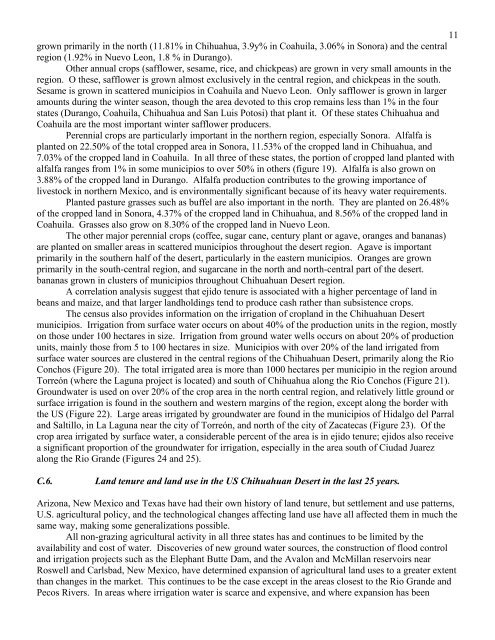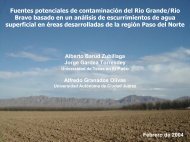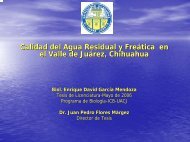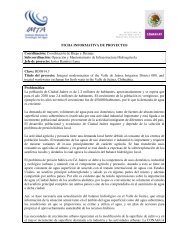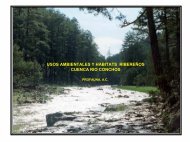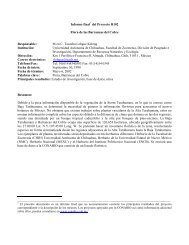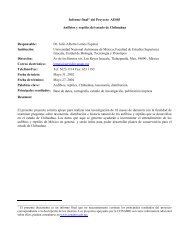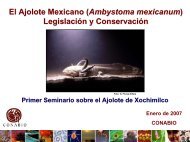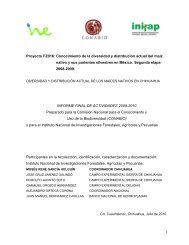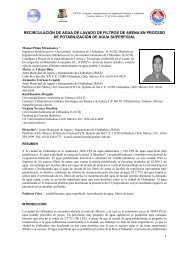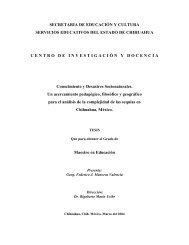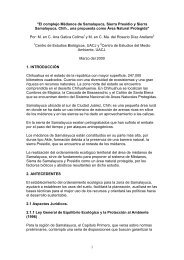land use and land tenure change in the - El Colegio de Chihuahua
land use and land tenure change in the - El Colegio de Chihuahua
land use and land tenure change in the - El Colegio de Chihuahua
You also want an ePaper? Increase the reach of your titles
YUMPU automatically turns print PDFs into web optimized ePapers that Google loves.
11grown primarily <strong>in</strong> <strong>the</strong> north (11.81% <strong>in</strong> <strong>Chihuahua</strong>, 3.9y% <strong>in</strong> Coahuila, 3.06% <strong>in</strong> Sonora) <strong>and</strong> <strong>the</strong> centralregion (1.92% <strong>in</strong> Nuevo Leon, 1.8 % <strong>in</strong> Durango).O<strong>the</strong>r annual crops (safflower, sesame, rice, <strong>and</strong> chickpeas) are grown <strong>in</strong> very small amounts <strong>in</strong> <strong>the</strong>region. O <strong>the</strong>se, safflower is grown almost exclusively <strong>in</strong> <strong>the</strong> central region, <strong>and</strong> chickpeas <strong>in</strong> <strong>the</strong> south.Sesame is grown <strong>in</strong> scattered municipios <strong>in</strong> Coahuila <strong>and</strong> Nuevo Leon. Only safflower is grown <strong>in</strong> largeramounts dur<strong>in</strong>g <strong>the</strong> w<strong>in</strong>ter season, though <strong>the</strong> area <strong>de</strong>voted to this crop rema<strong>in</strong>s less than 1% <strong>in</strong> <strong>the</strong> fourstates (Durango, Coahuila, <strong>Chihuahua</strong> <strong>and</strong> San Luis Potosi) that plant it. Of <strong>the</strong>se states <strong>Chihuahua</strong> <strong>and</strong>Coahuila are <strong>the</strong> most important w<strong>in</strong>ter safflower producers.Perennial crops are particularly important <strong>in</strong> <strong>the</strong> nor<strong>the</strong>rn region, especially Sonora. Alfalfa isplanted on 22.50% of <strong>the</strong> total cropped area <strong>in</strong> Sonora, 11.53% of <strong>the</strong> cropped <strong>l<strong>and</strong></strong> <strong>in</strong> <strong>Chihuahua</strong>, <strong>and</strong>7.03% of <strong>the</strong> cropped <strong>l<strong>and</strong></strong> <strong>in</strong> Coahuila. In all three of <strong>the</strong>se states, <strong>the</strong> portion of cropped <strong>l<strong>and</strong></strong> planted withalfalfa ranges from 1% <strong>in</strong> some municipios to over 50% <strong>in</strong> o<strong>the</strong>rs (figure 19). Alfalfa is also grown on3.88% of <strong>the</strong> cropped <strong>l<strong>and</strong></strong> <strong>in</strong> Durango. Alfalfa production contributes to <strong>the</strong> grow<strong>in</strong>g importance oflivestock <strong>in</strong> nor<strong>the</strong>rn Mexico, <strong>and</strong> is environmentally significant beca<strong>use</strong> of its heavy water requirements.Planted pasture grasses such as buffel are also important <strong>in</strong> <strong>the</strong> north. They are planted on 26.48%of <strong>the</strong> cropped <strong>l<strong>and</strong></strong> <strong>in</strong> Sonora, 4.37% of <strong>the</strong> cropped <strong>l<strong>and</strong></strong> <strong>in</strong> <strong>Chihuahua</strong>, <strong>and</strong> 8.56% of <strong>the</strong> cropped <strong>l<strong>and</strong></strong> <strong>in</strong>Coahuila. Grasses also grow on 8.30% of <strong>the</strong> cropped <strong>l<strong>and</strong></strong> <strong>in</strong> Nuevo Leon.The o<strong>the</strong>r major perennial crops (coffee, sugar cane, century plant or agave, oranges <strong>and</strong> bananas)are planted on smaller areas <strong>in</strong> scattered municipios throughout <strong>the</strong> <strong>de</strong>sert region. Agave is importantprimarily <strong>in</strong> <strong>the</strong> sou<strong>the</strong>rn half of <strong>the</strong> <strong>de</strong>sert, particularly <strong>in</strong> <strong>the</strong> eastern municipios. Oranges are grownprimarily <strong>in</strong> <strong>the</strong> south-central region, <strong>and</strong> sugarcane <strong>in</strong> <strong>the</strong> north <strong>and</strong> north-central part of <strong>the</strong> <strong>de</strong>sert.bananas grown <strong>in</strong> clusters of municipios throughout <strong>Chihuahua</strong>n Desert region.A correlation analysis suggest that ejido <strong>tenure</strong> is associated with a higher percentage of <strong>l<strong>and</strong></strong> <strong>in</strong>beans <strong>and</strong> maize, <strong>and</strong> that larger <strong>l<strong>and</strong></strong>hold<strong>in</strong>gs tend to produce cash ra<strong>the</strong>r than subsistence crops.The census also provi<strong>de</strong>s <strong>in</strong>formation on <strong>the</strong> irrigation of crop<strong>l<strong>and</strong></strong> <strong>in</strong> <strong>the</strong> <strong>Chihuahua</strong>n Desertmunicipios. Irrigation from surface water occurs on about 40% of <strong>the</strong> production units <strong>in</strong> <strong>the</strong> region, mostlyon those un<strong>de</strong>r 100 hectares <strong>in</strong> size. Irrigation from ground water wells occurs on about 20% of productionunits, ma<strong>in</strong>ly those from 5 to 100 hectares <strong>in</strong> size. Municipios with over 20% of <strong>the</strong> <strong>l<strong>and</strong></strong> irrigated fromsurface water sources are clustered <strong>in</strong> <strong>the</strong> central regions of <strong>the</strong> <strong>Chihuahua</strong>n Desert, primarily along <strong>the</strong> RioConchos (Figure 20). The total irrigated area is more than 1000 hectares per municipio <strong>in</strong> <strong>the</strong> region aroundTorreón (where <strong>the</strong> Laguna project is located) <strong>and</strong> south of <strong>Chihuahua</strong> along <strong>the</strong> Rio Conchos (Figure 21).Groundwater is <strong>use</strong>d on over 20% of <strong>the</strong> crop area <strong>in</strong> <strong>the</strong> north central region, <strong>and</strong> relatively little ground orsurface irrigation is found <strong>in</strong> <strong>the</strong> sou<strong>the</strong>rn <strong>and</strong> western marg<strong>in</strong>s of <strong>the</strong> region, except along <strong>the</strong> bor<strong>de</strong>r with<strong>the</strong> US (Figure 22). Large areas irrigated by groundwater are found <strong>in</strong> <strong>the</strong> municipios of Hidalgo <strong>de</strong>l Parra<strong>l<strong>and</strong></strong> Saltillo, <strong>in</strong> La Laguna near <strong>the</strong> city of Torreón, <strong>and</strong> north of <strong>the</strong> city of Zacatecas (Figure 23). Of <strong>the</strong>crop area irrigated by surface water, a consi<strong>de</strong>rable percent of <strong>the</strong> area is <strong>in</strong> ejido <strong>tenure</strong>; ejidos also receivea significant proportion of <strong>the</strong> groundwater for irrigation, especially <strong>in</strong> <strong>the</strong> area south of Ciudad Juarezalong <strong>the</strong> Rio Gr<strong>and</strong>e (Figures 24 <strong>and</strong> 25).C.6.L<strong>and</strong> <strong>tenure</strong> <strong>and</strong> <strong>l<strong>and</strong></strong> <strong>use</strong> <strong>in</strong> <strong>the</strong> US <strong>Chihuahua</strong>n Desert <strong>in</strong> <strong>the</strong> last 25 years.Arizona, New Mexico <strong>and</strong> Texas have had <strong>the</strong>ir own history of <strong>l<strong>and</strong></strong> <strong>tenure</strong>, but settlement <strong>and</strong> <strong>use</strong> patterns,U.S. agricultural policy, <strong>and</strong> <strong>the</strong> technological <strong>change</strong>s affect<strong>in</strong>g <strong>l<strong>and</strong></strong> <strong>use</strong> have all affected <strong>the</strong>m <strong>in</strong> much <strong>the</strong>same way, mak<strong>in</strong>g some generalizations possible.All non-graz<strong>in</strong>g agricultural activity <strong>in</strong> all three states has <strong>and</strong> cont<strong>in</strong>ues to be limited by <strong>the</strong>availability <strong>and</strong> cost of water. Discoveries of new ground water sources, <strong>the</strong> construction of flood contro<strong>l<strong>and</strong></strong> irrigation projects such as <strong>the</strong> <strong>El</strong>ephant Butte Dam, <strong>and</strong> <strong>the</strong> Avalon <strong>and</strong> McMillan reservoirs nearRoswell <strong>and</strong> Carlsbad, New Mexico, have <strong>de</strong>term<strong>in</strong>ed expansion of agricultural <strong>l<strong>and</strong></strong> <strong>use</strong>s to a greater extentthan <strong>change</strong>s <strong>in</strong> <strong>the</strong> market. This cont<strong>in</strong>ues to be <strong>the</strong> case except <strong>in</strong> <strong>the</strong> areas closest to <strong>the</strong> Rio Gr<strong>and</strong>e <strong>and</strong>Pecos Rivers. In areas where irrigation water is scarce <strong>and</strong> expensive, <strong>and</strong> where expansion has been


